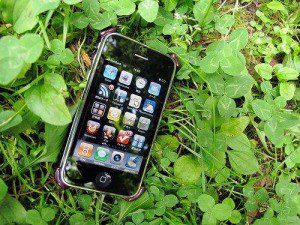29th May 2014
Contributing Writer for Wake Up World
Consumers will soon have the power to conduct on the spot tests for a variety of poisons in their food — including GMOs, nanoparticals, pesticides and bacteria. Using smartphone technology, along with a specialized cradle and app, researchers have developed a biosensor that identifies various toxins, bacteria, viruses, proteins and other molecules in mere seconds. With the pervasiveness of GMOs and other dangerous elements infiltrating our food supply at every turn, using modern technology to add another layer of protection against these hazards is a smart move.
As unbelievable as it may seem, the average person contends with an astounding amount of environmental pollutants on a daily basis. Prevent Disease drives the point home in the article, “Consumers Will Soon Have Devices In Their Hands To Detect GMO and Toxic Foods”:
“Every human being on every developed nation on Earth, whether living in a rural or isolated area, in the middle of a large city, or near an industrialized area, now contains at least 700 contaminants in their body including pesticides, phthalates, benzenes, parabens, xylenes and many other carcinogenic and endocrine disrupting chemicals.”
The human body has turned into a toxic waste dump, and drastic measures are needed simply to maintain a modicum of health and prevent serious disease. It’s high time we know exactly what is in our food — and technology just may provide a solution.
The Role of Smartphones
Brian Cunnigham, a professor of electrical and computer engineering and of bioengineering at the University of Illinois, believes that “smartphones are making a big impact on our society — the way we get our information, the way we communicate.” And he sees the value in creating mobile platforms that inexpensively and non-invasively detect pathogens, disease biomarkers, DNA or even GMOs.
In response, Cunnigham’s team has created a wedge-shaped cradle that has a series of lenses and filters which are similar to much larger (and more expensive) laboratory instruments. The phone’s camera is held in alignment with these optical elements by a cradle. According to Prevent Disease:
“At the heart of the biosensor is a photonic crystal. A photonic crystal is like a mirror that only reflects one wavelength of light while the rest of the spectrum passes through. When anything biological attaches to the photonic crystal — such as protein, cells, pathogens or DNA — the reflected color will shift from a shorter wavelength to a longer wavelength.”
Step by step instructions walk the user through the process, which takes only a minute or two. As accurate as a $50,000 lab spectrophotometer, the cradle utilizes around $200 worth of optical parts. Not only cost-effective, the device is also extremely portable for fieldwork in developing nations — as well as for day-to-day use by health conscious consumers.
The researchers are currently improving manufacturing processes for the iPhone cradle, with an Android version in the works as well. Cunnigham and his team are aiming for a public release sometime this year.
Sources for this article include:
http://www.ece.illinois.edu/directory/profile.asp?bcunning
http://science.naturalnews.com/pubmed/19579682.html
Previous articles by Carolanne:
- Colorado Rolls Out State-of-the-Art Medical Marijuana Vending Machines
- Coconut Sugar: Enjoy the New Star Among Low Glycemic Sweeteners
- $300 Underground Greenhouse Grows Produce Year-Round, Even in Severe Climates
- Hemp – The Ultimate Cash Crop, Health Food and Environmental Savior Rolled Into One
-
Europe Embraces Healthy Raw Dairy by Unveiling Fresh Milk Vending Machines
- Confirmed by Science: You Really Can Change Your DNA – Here’s How
- Top 10 Food Frauds: Formaldehyde, Plastic, Melamine & Caustic Soda Found in Common Foods
- Autistic Boy With Higher IQ Than Einstein Discovers Gift After Removal From State-Run Therapy
-
Enhance Spiritual, Mental and Physical Well-being with a Pineal Gland Detox
- Enterprising Community Aims for Total Food Self-Sufficiency with Free Edible Landscapes
- The Silent Toxin in Food that Provokes Cancer, Diabetes, Multiple Sclerosis and More
- Dying to be Healthy: Many Protein Powders Laced with Heavy Metals and MSG
- Want to Maximize Supplement Absorption? Try Transdermal Nutrients
- Four Specialty Salts That Can Change Your Health For The Better
About the author:
I’m Carolanne — a writer, chef, traveler and enthusiastic advocate for sustainability, organics and joyful living. It’s good to have you here. If you would like to learn more, connect with me at Thrive-Living.net or visit Twitter.com/Thrive_Living.
If you've ever found value in our articles, we'd greatly appreciate your support by purchasing Mindful Meditation Techniques for Kids - A Practical Guide for Adults to Empower Kids with the Gift of Inner Peace and Resilience for Life.
In the spirit of mindfulness, we encourage you to choose the paperback version. Delve into its pages away from screen glare and notifications, allowing yourself to fully immerse in the transformative practices within. The physical book enriches the learning process and serves as a tangible commitment to mindfulness, easily shared among family and friends.
Over the past few years, Wake Up World has faced significant online censorship, impacting our financial ability to stay online. Instead of soliciting donations, we're exploring win-win solutions with our readers to remain financially viable. Moving into book publishing, we hope to secure ongoing funds to continue our mission. With over 8,500 articles published in the past 13 years, we are committed to keeping our content free and accessible to everyone, without resorting to a paywall.
Please note: this article was first published on Natural News.








